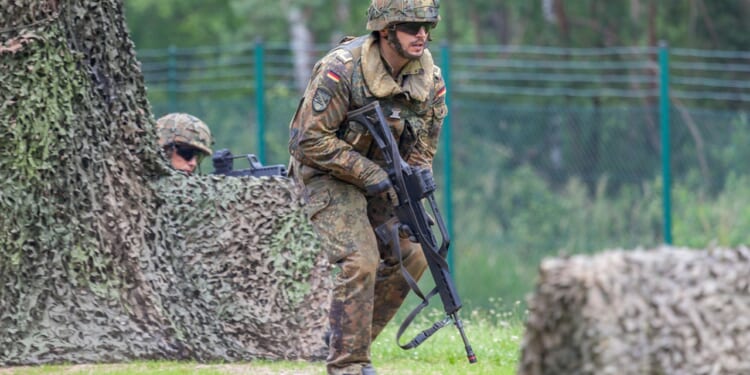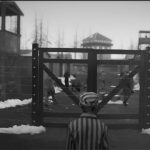The Bundeswehr, Germany’s armed forces, aims to equip all soldiers with high-performing “Multitarn” camouflage uniforms by 2029.
Germany’s Bundeswehr currently has about 280,000 troops in uniform, but as part of the NATO member’s “FASER” program, it could expand this number to 460,000 troops by the mid-2030s. The increased number of personnel will require new uniforms and personal equipment. This week, Berlin will allocate roughly €19 billion ($22.16 billion) to ensure the troops can be clothed and equipped accordingly, Reuters first reported.
In addition to the uniforms and personal equipment, 7.5 billion ($8.7 billion) has been authorized for the purchase of “Schakal” wheeled infantry fighting vehicles, produced as part of a cooperation deal between Rheinmetall and the Franco-German KNDS.
After years of declining defense budgets, Germany is once again investing in military hardware, spurred by Russia’s unprovoked invasion of Ukraine in February 2022.
Berlin has remained committed to reaching NATO’s defense spending goals, and for 2026, Germany’s total defense spending, including funds from special accounts, will reach €117.2 billion ($135.9 billion), roughly 2.8 percent of its gross domestic product (GDP). Germany is ultimately committed to spending 5 percent of GDP on defense, in line with guarantees made at NATO’s recent summit in The Hague, Netherlands.
Germany’s New “Multitarn” Military Camouflage
The recent report didn’t specify the types of uniforms being purchased, but it is likely to include service uniforms and a new combat battle dress. In August, the Bundeswehr announced that it would follow the lead of the United Kingdom, a NATO ally, and adopt a single camouflage pattern as its primary military uniform.
The “Multitarn” pattern, which is currently employed by German military Special Forces units, will replace the “Flecktarn” and “Tropentarn” uniforms now used by the remainder of the armed forces. The new camouflage is expected to be introduced to units beginning next year and will be universally adopted by 2029.
The German Ministry of Defense had previously resisted the wide-scale adoption of the pattern due to the high costs of replacing the entire military’s uniforms. However, it relented after studies conducted by Wehrwissenschaftliches Institut für Werk- und Betriebsstoffe, the research body of the Bundeswehr, determined that the Multitarn pattern would provide improved concealment in a variety of operational environments, notably in urban settings. The study considered recent battlefield experiences, including those in Ukraine, where both sides have conducted operations across a variety of terrains, from heavily wooded areas to urban centers.
The research body also noted that the German Army’s Special Forces Command (KSK) and the German Navy’s Special Forces Command (KSM), which wore the pattern, could be easier to identify in the field if they were the only personnel outfitted with Multicam camouflage.
The British military underwent a transformation to the Multi-Terrain Pattern (MTP) camouflage pattern following experiences in Afghanistan and Iraq, where the previous Disruptive Pattern Material (DPM) and its desert variant were phased out in favor of the new MTP. DPM had become the standard camouflage pattern in the late 1960s and was used in the 1982 Falklands Island War, as well as with the desert variant in operations in the Middle East. However, it was determined that neither variant was well-suited to a multitude of terrains.
Germany’s Long History with Camouflage Uniforms
There is some irony that it has taken so long for the Bundeswehr to universally adopt multitarn, as its military pioneered the use of camouflage during the two World Wars of the 20th century. During World War I, German troops were the first to apply camouflage to their steel helmets to break up the glare from the factory paint. The Reichswehr, Germany’s interwar military force, also experimented with camouflage techniques prior to the Nazis’ rise to power in 1933. The first mass-produced camouflage pattern in the world was the “Splittermuster” (splinter pattern), which was introduced in 1931.
During World War II, Germany was the most prolific developer and user of camouflage. In fact, because of the uniforms’ widespread use by the Nazis, the United States Army even withdrew their early camouflage uniforms from use in Europe after they were determined to be too close to a pattern employed by the infamous Waffen-SS. There was a valid concern that other Allied units would mistake the Americans for Germans. Instead, the US military relegated the camouflage uniforms to the Pacific, where the Japanese used regular uniforms.
The various patterns used by the Germans in the war in Europe went on to influence the camouflage used by other nations for decades to come—contributing to the ubiquity that the patterns now enjoy with militaries around the world.
About the Author: Peter Suciu
Peter Suciu has contributed over 3,200 published pieces to more than four dozen magazines and websites over a 30-year career in journalism. He regularly writes about military hardware, firearms history, cybersecurity, politics, and international affairs. Peter is also a contributing writer for Forbes and Clearance Jobs. He is based in Michigan. You can follow him on Twitter: @PeterSuciu. You can email the author: [email protected].
Image: Shutterstock / Filmbildfabrik.

















